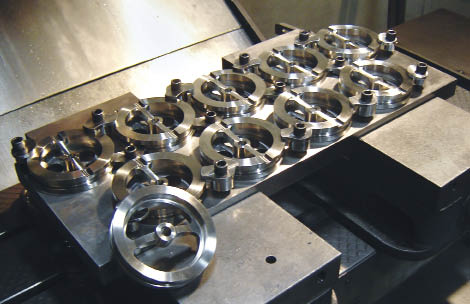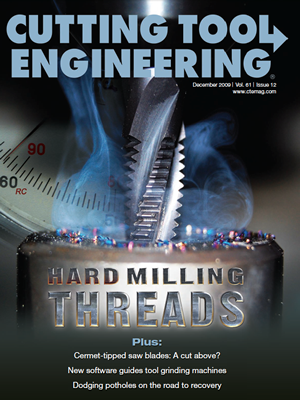R&M Manufacturing Inc. provides machining, assembly and custom fabrication services. An ISO 9001:2008-certified company, R&M focuses on continually exceeding customer requirements.
In the course of developing a machining process for a 3¾ "-OD, ¾ "-thick 316-L stainless steel retainer used in food processing equipment, R&M engineered an efficient workholding system and changed the casting method for the workpiece material. As a result, the Milton, Wis., shop was able to reduce scrap and cycle time while fulfilling the customer’s strict surface finish requirements.
The machining process involved two operations on a CNC lathe and one on a vertical machining center. Working from a customer-provided part print, the shop created machining programs in GibbsCAM software for a Warner & Swasey WSC-6 lathe and a Fadal 2216 VMC.

Courtesy of R&M Manufacturing
R&M Manufacturing engineered an efficient workholding setup and later changed the method used to cast workpiece blanks when machining stainless steel retainers used in food processing equipment.
For machining on the lathe, the rough casting was clamped in stepped soft jaws. The first operation involved turning the retainer’s OD for approximately half of its length, machining the contour of the part’s face and drilling a 0.374 "-dia. axial hole in the part’s center with a carbide drill. The hole was then reamed to a diameter of 0.377 ".
For the second operation, the part was flipped in the chuck and the remaining section of the OD was turned. Then, a 0.250 "-wide × 0.158 "-deep O-ring groove was machined on the OD. In the same operation, the end of the part was faced and counterbored.
For the turning operations, R&M employed Mitsubishi grade-US735 inserts, run at approximately 700 sfm. Manufacturing Engineer Jim Cagle said the operations on the lathe required tolerances of 0.000 "/- 0.001 " for the OD and 0.0005 "/-0.0000 " for the center hole.
On the VMC, Mitsubishi endmills applied at 350 sfm and 25 ipm milled the inside profile of the retainer and cut two 0.375 "-wide × 0.125 "-deep slots in the face of each part. To hold the retainers for this operation, R&M designed a fixture that handles nine parts simultaneously. Cagle noted that secure workholding was essential to maintain the 32µin. Ra surface finish the part required. To assure consistent part location, the fixture plate’s base was fitted with pins that matched the central axial hole in each part.
Radial cutting forces were another concern. “Doing that contour, we were pushing the part, and it did have a tendency to rotate,” Cagle said. That tendency was overcome by a series of 15 clamps. Every retainer was secured by a minimum of three clamps; some of the clamps contacted two or three parts, engaging the top sides or O-ring grooves of the retainers. “The more contact points, the more stable it was,” Cagle said.
After initial part runs, changing the casting process for the retainer blanks helped R&M achieve significant productivity improvements. The opportunity to try a new process arrived following a change in R&M’s role in the production of the retainers. R&M originally began machining the parts as a subcontractor for the OEM. Initially, the OEM provided sand-cast blanks of the 316-L stainless steel and paid R&M to rough and finish machine them. However, the blanks often exhibited unacceptable amounts of porosity. As a result, the scrap rate was about 15 percent. In addition, the rough castings featured about 3⁄32 " of excess stock per side, requiring both roughing and finishing passes to achieve the desired final dimensions and surface finish.
R&M eventually gained total responsibility for producing the retainers, including sourcing the castings. It was decided to have the blanks produced via the investment casting process, a version of the loss-wax method that employs a wax or foam master to create a refractory (ceramic) mold of the part. After the wax is removed, the part is cast in the mold.
For the retainers, the as-cast surface finish produced by the smooth ceramic was much finer than that produced by sand casting, and the casting’s higher precision minimized the amount of excess stock that needed to be removed. The new casting method yielded a porosity-free part and less material to remove. “We were only taking off about 0.015 " per side,” Cagle said. “We were able to eliminate roughing completely.”
Following the change to investment casting, Cagle said, the scrap rate became negligible and the elimination of roughing passes reduced cycle time by about 30 percent. R&M typically produced the strainer in lots of 100 parts, with a lead time of 2 weeks. CTE
For more information about R&M Manufacturing Inc., call (608) 868-5081 or visit www.rmmfginc.com.
Related Glossary Terms
- chuck
chuck
Workholding device that affixes to a mill, lathe or drill-press spindle. It holds a tool or workpiece by one end, allowing it to be rotated. May also be fitted to the machine table to hold a workpiece. Two or more adjustable jaws actually hold the tool or part. May be actuated manually, pneumatically, hydraulically or electrically. See collet.
- computer numerical control ( CNC)
computer numerical control ( CNC)
Microprocessor-based controller dedicated to a machine tool that permits the creation or modification of parts. Programmed numerical control activates the machine’s servos and spindle drives and controls the various machining operations. See DNC, direct numerical control; NC, numerical control.
- fixture
fixture
Device, often made in-house, that holds a specific workpiece. See jig; modular fixturing.
- inches per minute ( ipm)
inches per minute ( ipm)
Value that refers to how far the workpiece or cutter advances linearly in 1 minute, defined as: ipm = ipt 5 number of effective teeth 5 rpm. Also known as the table feed or machine feed.
- investment casting
investment casting
1. Casting metal into a mold produced by surrounding (investing) an expandable pattern with a refractory slurry that sets at room temperature, after which the wax, plastic or frozen-mercury pattern is removed through the use of heat. Also called precision casting or lost-wax process. 2. Part made by the investment-casting process.
- lathe
lathe
Turning machine capable of sawing, milling, grinding, gear-cutting, drilling, reaming, boring, threading, facing, chamfering, grooving, knurling, spinning, parting, necking, taper-cutting, and cam- and eccentric-cutting, as well as step- and straight-turning. Comes in a variety of forms, ranging from manual to semiautomatic to fully automatic, with major types being engine lathes, turning and contouring lathes, turret lathes and numerical-control lathes. The engine lathe consists of a headstock and spindle, tailstock, bed, carriage (complete with apron) and cross slides. Features include gear- (speed) and feed-selector levers, toolpost, compound rest, lead screw and reversing lead screw, threading dial and rapid-traverse lever. Special lathe types include through-the-spindle, camshaft and crankshaft, brake drum and rotor, spinning and gun-barrel machines. Toolroom and bench lathes are used for precision work; the former for tool-and-die work and similar tasks, the latter for small workpieces (instruments, watches), normally without a power feed. Models are typically designated according to their “swing,” or the largest-diameter workpiece that can be rotated; bed length, or the distance between centers; and horsepower generated. See turning machine.
- machining center
machining center
CNC machine tool capable of drilling, reaming, tapping, milling and boring. Normally comes with an automatic toolchanger. See automatic toolchanger.
- outer diameter ( OD)
outer diameter ( OD)
Dimension that defines the exterior diameter of a cylindrical or round part. See ID, inner diameter.
- turning
turning
Workpiece is held in a chuck, mounted on a face plate or secured between centers and rotated while a cutting tool, normally a single-point tool, is fed into it along its periphery or across its end or face. Takes the form of straight turning (cutting along the periphery of the workpiece); taper turning (creating a taper); step turning (turning different-size diameters on the same work); chamfering (beveling an edge or shoulder); facing (cutting on an end); turning threads (usually external but can be internal); roughing (high-volume metal removal); and finishing (final light cuts). Performed on lathes, turning centers, chucking machines, automatic screw machines and similar machines.


